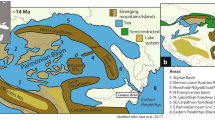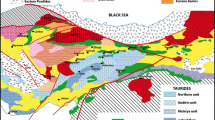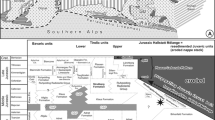Abstract
In the central Iranian Esfahan-Sirjan and Qom basins sedimentation of the Oligo-/Miocene Qom Formation took place on extensive mixed carbonate–siliciclastic ramps. During this time, both basins were positioned at the Eurasian margin of the Tethyan Seaway, which connected the western and eastern regions of the Tethys Ocean at least until the late Burdigalian. During the so-called Terminal Tethyan Event the Tethyan Seaway was then closed due to the collision of the African/Arabian and Iranian/Eurasian plates. Facies analysis of the sedimentary record of both basins indicates paleoenvironments ranging from terrestrial to open marine settings, including mangrove, restricted inner shelf lagoon, seagrass meadow, reefal, and deeper offshore environments. Recognition of eight depositional sequences and elaboration of an integrated biostratigraphic framework (calcareous nannoplankton, planktic and larger benthic foraminifers, gastropods, and pectinids) allow us to construct a basin-spanning stratigraphy. The assignment of the recognized sea-level lowstands to the Ru 3 to Bur 3 lowstands of the global sea-level curve enables a comparison with time-equivalent sections from the Zagros Basin, which was part of the African/Arabian Plate on the opposing southern margin of the Tethyan Seaway. The so calibrated sections display restrictions of the Tethyan Seaway and interruption of the south Iranian gateways between the Qom Basin and the Proto-Indopacific in relation to ongoing plate collision during the early Burdigalian.













Similar content being viewed by others
References
Abaie IL, Ansari HJ, Badakhshan A, Jaafaki A (1963) History and development of the Alborz and Seraih fields, central Iran. In: Proc 6th world petrol conf, Frankfurt, pp 1–111
Adams CG (1968) A revision of the foraminiferal genus Austrotrillina Parr. Bull Brit Nat Hist Geol 16:73–97
Adams CG, Gentry AW, Whybrow PJ (1983) Dating the terminal Tethyan event. Utrecht Micropaleontol Bull 30:273–298
Ala MA (1982) Chronology of trap formation and migration of hydrocarbons in Zagros sector of southwest Iran. AAPG Bull 66:1536–1542
Alsharhan AS, Nairn AEM (1995) Tertiary of the Arabian Gulf: sedimentology and hydrocarbon potential. Palaeogeogr Palaeoclimatol Palaeoecol 114:369–384
Amidi SM (1983) Abadeh. Geological quadrangle map of Iran no. G9. Scale 1:250 000. Ministery of Mines and Metals and Geol Surv Iran
Amidi SM, Zahedi M (1991) Kashan. Geological quadrangle map of Iran no. F7. Scale 1:250 000. Ministery of Mines and Metals and Geol Surv Iran
Beavington-Penny SJ, Wright VP, Racey A (2006) The middle Eocene Seeb formation of Oman: an investigation of acyclicity, stratigraphic completeness, and accumulation rates in shallow marine carbonate settings. J Sed Res 76:1137–1161
Berggren WA, Kent DV, Aubry MP, Hardenbol J (1995) Geochronology, time scales and global stratigraphic correlation. SEPM Spec Publ 54:1–386
Bizon G, Bizon JJ (1972) Atlas des pincipaux foraminiféres planctoniques du basin méditerranéen. Oligocéne á quaternaire IX:1–316
Bolli HM, Saunders JB (1985) Oligocene to Holocene low latitude planktic foraminifera. In: Bolli HM, Saunders JB, Perch-Nielsen K (eds) Plankton stratigraphy. Cambridge University Press, London, pp 155–262
BouDhager-Fadel M, Banner FT (1999) Revision of the stratigraphic significance of the Oligo-Miocene “Letter-Stages”. Rev Micropaleontol 42(2):93–97
Bozorgnia F (1966) Qum formation stratigraphy of the Central Basin of Iran and its intercontinental position. Bull Iran Petrol Inst 24:69–76
Cahuzac B, Poignant A (1997) Essai de biozonation de l`Oligo-Miocène dans les bassins europèens à l’aide des grands foraminifères nèritiques. Bull Soc Gèol Fr 168:155–169
Chahida MR, Papp A, Steininger F (1977) Fossilführung der Oligo/Miozänen Qum-formation in Profilen bei Abegarm-Zefreh bei Isfahan (Zentraliran). Beitr Paläont Österr 2:79–93
Coleman-Sadd SP (1982) Two stage continental collision and plate driving forces. Tectonophysics 90:263–282
Ctyroky P, Karim SA, van Vessem EJ (1975) Miogypsina and Borelis in the Euphrate limestone formation in the Western Desert of Iraq. N Jb Geol Paläont Abh 148:33–49
Emami MH (1991) Qom. Geological quadrangle map of Iran no. E6. scale 1:250 000. Ministery of Mines and Metals and Geol Surv Iran
Furrer MA, Soder PA (1955) The Oligo-Miocene formation in the Qum region (Iran). In: Proc IVth World Petroleum Congress, Roma, Italia
Hallock P (1985) Why are larger foraminifera large? Paleobiology 11:195–208
Hallock P, Glenn EC (1986) Larger foraminifera: a tool for paleoenvironmental analysis of Cenozoic carbonate depositional facies. Palaios 1:55–64
Hardenbol J, Thierry J, Farley MB, Jacquin T, De Gracianski PC, Vail PR (1998) Mesozoic and cenozoic sequence stratigraphic framework of European Basins. In: De Gracianski PC, Hardenbol J, Thierry J, Vail PR (eds) Mesozoic and cenozoic sequence stratigraphy of European basins. SEPM Spec Publ 60:3–14
Harzhauser M (2000) Paleobiogeography and Palecology of Oligocene and Lower Miocene Gastropods in the Eastern Mediterranean and the Western Indo-Pacific. PhD thesis, University of Vienna, p 259
Harzhauser M (2004) Oligocene gastropod faunas of the Eastern Mediterranean (Mesohellenic Trough/Greece and Esfahan-Sirjan Basin/Central Iran). Cour Forsch Inst Senckenberg 248:93–181
Harzhauser M, Piller WE (2007) Benchmark data of a changing sea—and events in the Central Paratethys during the Miocene. Palaeogeogr Palaeoclimatol Palaeoecol 253:8–31
Harzhauser M, Piller WE, Steininger FF (2002) Circum-mediterranean Oligo-/Miocene biogeographic evolution—the gastropods’ point of view. Palaeogeogr Palaeoclimatol Palaeoecol 183:103–133
Harzhauser M, Kroh A, Mandic O, Piller WE, Göhlich U, Reuter M, Berning B (2007) Biogeographic responses to geodynamics: a key study all around the Oligo-Miocene Tethyan Seaway. Zool Anz 246:241–256
Iaccarino S (1985) Mediterranean Miocene and Pliocene planktic foraminifera. In: Bolli HM, Saunders JB, Perch-Nielsen K (eds) Plankton stratigraphy. Cambridge University Press, London, pp 283–314
Jones WR (1999) Marine invertebrate (chiefly foraminiferal) evidence for the paleogeography of the Oligocene-Miocene of Eurasia, and consequences for terrestrial vertebrate migration. In: Agusti J, Rook L, Andrews P (eds) Hominid evolution and environmental change in the Neogene of Europe. Cambridge University Press, London, pp 274–308
Kahng SE, Maragos JE (2006) The deepest, zooxanthellate scleractinian corals in the world? Coral Reefs 25:254
Mandic O (2000) Oligocene to early Miocene pectinid bivalves of Western Tethys (N-Greece, S-Turkey, Central Iran and NE-Egypt)—taxonomy and paleobiogeography. PhD thesis, University of Vienna, p 289
Mandic O, Steininger FF (2003) Computer-based mollusc stratigraphy—a case study from the Eggenburgian (Early Miocene) type region (NE Austria). Palaeogeogr Palaeoclimatol Palaeoecol 197:263–291
Martini E (1971) Standard tertiary and quaternary calcareous nannoplankton zonation, vol 2. In: Proc 2nd planktonic conf Roma, pp 739–785
Mostofi R, Gansser A (1957) The story behind the 5 Alborz. Oil Gas J 55:78–84
Nogole-Sadat MAA (1985) Les zones de decrochmentel Les virgations in Iran, consequences des resultats de LL de la region de Qom. Geol Surv Iran Rep 1–201
Okhravi R, Amini A (1998) An example of mixed carbonate-pyroclastic sedimentation (Miocene, Central Basin, Iran). Sediment Geol 118:37–54
Pedley M (1998) A review of sediment distributions and processes in Oligo-Miocene ramps of southern Italy and Malta (Mediterranean divide). In: Wright VP, Burchette TP (eds) Carbonate Ramps. Geol Soc Lond Spec Publs 149:163–179
Perrin C, Bosence D, Rosen B (1995) Quantitative approaches to paleozonation and paleobathymetry of corals and coralline algae in Cenozoic reefs. In: Bosence DWJ, Allison PA (eds) Marine palaeoenvironmental analysis from fossils. Geol Soc Lond Spec Publs 83:181–229
Rahaghi A (1973) Étude de quelque grands foraminiféres de la formation de Qum (Iran Central). Rev Micropal 16:23–38
Rahaghi A (1976) Contribution á l`étude de quelque grands foraminiféres de l´Iran. NIOC 6:1–79
Rahaghi A (1980) Tertiary faunal assemblage of Qum-Kashan, Sabzewar and Jahrum areas. NIOC 8:1–64
Robba E (1986) The final occlusion of Tethys: its bearing on Mediterranean benthic molluscs. Int Symp Shallow Tethys 2:405–426
Rögl F (1997) Paleogeographic considerations for Mediterranean and Paratethys Seaways (Oligocene to Miocene). Ann Naturhist Mus Wien 99A:279–310
Rögl F (1999) Mediterranean and Paratethys. Facts and hypotheses of an Oligocene to Miocene paleogeography (short overview). Geol Carpathica 50:339–349
Rögl F, Steininger FF (1983) Vom Zerfall der Tethys zu Mediterran und Paratethys. Ann Naturhist Mus Wien 85/A:135–163
Rögl F, Steininger FF (1984) Neogene Paratethys, Mediterranean and Indo-pacific seaways. In: Brenchley P (ed) Fossils and climate. Wiley, Chister, pp 171–200
Rosen BR, Aillud GS, Bosellini FR, Clack N, Insalaco E, Valldeperas FX, Wilson MEJ (2002) Platy coral assemblages: 200 million years of functional stability in response to the limiting effects of light and turbidity, vol 1. In: Proc 9th Int Coral Reefs Symp, Bali, pp 255–264
Rosenberg R (1975) Qum-1956: a misadventure in Iranian Oil. Bus Hist Rev 49:81–104
Schuster F, Wielandt U (1999) Oligocene and early Miocene coral faunas from Iran: paleoecology and paleobiogeography. Int J Earth Sci 88:571–581
Sen Gupta BK (1999) Foraminifera in marginal marine environments. In: Sen Gupta BK (ed) Modern foraminifera. Kluwer, Dordrecht, pp 141–159
Seyrafian A, Hamedani A (1998) Microfacies and depositional environment of the Upper Asmari formation (Burdigalian) North-Central Zagros Basin, Iran. N Jb Paläont Abh 210:129–141
Smith AM (1995) Palaeoenvironmental interpretation using bryozoans: a review. In: Bosence DWJ, Allison PA (eds) Marine palaeoenvironmental analysis from fossils. Geol Soc Lond Spec Publs 83:231–243
Stöcklin J, Setudehina A (1991) Stratigraphic lexicon of Iran. Geol Surv Iran Report 18, pp 1–376
Vaziri-Moghaddam H, Kimiagari M, Taheri A (2006) Depositional environment and sequence stratigraphy of the Oligo-Miocene Asmari formation in SW Iran. Facies 52:41–51
Wanless HR, Tedesco LP, Tyrell KM (1988) Production of subtidal tabular and surficial tempestites by Hurricane Kate, Caicos Platform, British West Indies. J Sediment Petrol 58:739–750
Wilson MEJ, Lokier SW (2002) Siliciclastic and volcaniclastic influences on equatorial carbonates: insights from the Neogene of Indonesia. Sedimentology 49:583–601
Whybrow PJ (1984) Geological and faunal evidence from Arabia for mammal migrations between Asia and Africa during the Miocene. Cour Forsch Inst Senckenberg 69:189–198
Woodroffe CD, Gagan MK (2000) Coral microatolls from the central Pacific record late Holocene El Niño. Geophys Res Lett 27:1511–1514
Zahedi M (1978) Esfahan. Geological quadrangle map of Iran no. J7. Scale 1:250 000. Ministery of Industry and Mines and Geol Surv Iran
Acknowledgments
Our special thanks go to the other members of the research projects on Late Oligocene—Early Miocene circum-Mediterranean palaeobiogeographical relations, the project leaders F. F. Steininger (Eggenburg) and J. H. Nebelsick (Tübingen), as well as the researchers M.W. Rasser (Stuttgart), J. Reisinger (Korneuburg), F. Schuster (Freiburg), and J. Schlaf (Aberdeen). We also appreciate the comments from an anonymous reviewer. This work was supported by the Austrian FWF (P11886-GEO) and the Deutsche Forschungsgemeinschaft (STE 857/1-1; NE 537/1-1, -2).
Author information
Authors and Affiliations
Corresponding author
Rights and permissions
About this article
Cite this article
Reuter, M., Piller, W.E., Harzhauser, M. et al. The Oligo-/Miocene Qom Formation (Iran): evidence for an early Burdigalian restriction of the Tethyan Seaway and closure of its Iranian gateways. Int J Earth Sci (Geol Rundsch) 98, 627–650 (2009). https://doi.org/10.1007/s00531-007-0269-9
Received:
Accepted:
Published:
Issue Date:
DOI: https://doi.org/10.1007/s00531-007-0269-9




